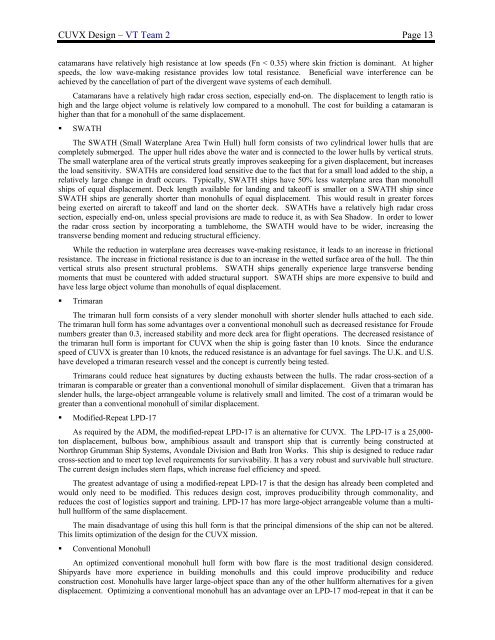CUVX Design Report - the AOE home page - Virginia Tech
CUVX Design Report - the AOE home page - Virginia Tech
CUVX Design Report - the AOE home page - Virginia Tech
You also want an ePaper? Increase the reach of your titles
YUMPU automatically turns print PDFs into web optimized ePapers that Google loves.
<strong>CUVX</strong> <strong>Design</strong> – VT Team 2 Page 13catamarans have relatively high resistance at low speeds (Fn < 0.35) where skin friction is dominant. At higherspeeds, <strong>the</strong> low wave-making resistance provides low total resistance. Beneficial wave interference can beachieved by <strong>the</strong> cancellation of part of <strong>the</strong> divergent wave systems of each demihull.Catamarans have a relatively high radar cross section, especially end-on. The displacement to length ratio ishigh and <strong>the</strong> large object volume is relatively low compared to a monohull. The cost for building a catamaran ishigher than that for a monohull of <strong>the</strong> same displacement.• SWATHThe SWATH (Small Waterplane Area Twin Hull) hull form consists of two cylindrical lower hulls that arecompletely submerged. The upper hull rides above <strong>the</strong> water and is connected to <strong>the</strong> lower hulls by vertical struts.The small waterplane area of <strong>the</strong> vertical struts greatly improves seakeeping for a given displacement, but increases<strong>the</strong> load sensitivity. SWATHs are considered load sensitive due to <strong>the</strong> fact that for a small load added to <strong>the</strong> ship, arelatively large change in draft occurs. Typically, SWATH ships have 50% less waterplane area than monohullships of equal displacement. Deck length available for landing and takeoff is smaller on a SWATH ship sinceSWATH ships are generally shorter than monohulls of equal displacement. This would result in greater forcesbeing exerted on aircraft to takeoff and land on <strong>the</strong> shorter deck. SWATHs have a relatively high radar crosssection, especially end-on, unless special provisions are made to reduce it, as with Sea Shadow. In order to lower<strong>the</strong> radar cross section by incorporating a tumble<strong>home</strong>, <strong>the</strong> SWATH would have to be wider, increasing <strong>the</strong>transverse bending moment and reducing structural efficiency.While <strong>the</strong> reduction in waterplane area decreases wave-making resistance, it leads to an increase in frictionalresistance. The increase in frictional resistance is due to an increase in <strong>the</strong> wetted surface area of <strong>the</strong> hull. The thinvertical struts also present structural problems. SWATH ships generally experience large transverse bendingmoments that must be countered with added structural support. SWATH ships are more expensive to build andhave less large object volume than monohulls of equal displacement.• TrimaranThe trimaran hull form consists of a very slender monohull with shorter slender hulls attached to each side.The trimaran hull form has some advantages over a conventional monohull such as decreased resistance for Froudenumbers greater than 0.3, increased stability and more deck area for flight operations. The decreased resistance of<strong>the</strong> trimaran hull form is important for <strong>CUVX</strong> when <strong>the</strong> ship is going faster than 10 knots. Since <strong>the</strong> endurancespeed of <strong>CUVX</strong> is greater than 10 knots, <strong>the</strong> reduced resistance is an advantage for fuel savings. The U.K. and U.S.have developed a trimaran research vessel and <strong>the</strong> concept is currently being tested.Trimarans could reduce heat signatures by ducting exhausts between <strong>the</strong> hulls. The radar cross-section of atrimaran is comparable or greater than a conventional monohull of similar displacement. Given that a trimaran hasslender hulls, <strong>the</strong> large-object arrangeable volume is relatively small and limited. The cost of a trimaran would begreater than a conventional monohull of similar displacement.• Modified-Repeat LPD-17As required by <strong>the</strong> ADM, <strong>the</strong> modified-repeat LPD-17 is an alternative for <strong>CUVX</strong>. The LPD-17 is a 25,000-ton displacement, bulbous bow, amphibious assault and transport ship that is currently being constructed atNorthrop Grumman Ship Systems, Avondale Division and Bath Iron Works. This ship is designed to reduce radarcross-section and to meet top level requirements for survivability. It has a very robust and survivable hull structure.The current design includes stern flaps, which increase fuel efficiency and speed.The greatest advantage of using a modified-repeat LPD-17 is that <strong>the</strong> design has already been completed andwould only need to be modified. This reduces design cost, improves producibility through commonality, andreduces <strong>the</strong> cost of logistics support and training. LPD-17 has more large-object arrangeable volume than a multihullhullform of <strong>the</strong> same displacement.The main disadvantage of using this hull form is that <strong>the</strong> principal dimensions of <strong>the</strong> ship can not be altered.This limits optimization of <strong>the</strong> design for <strong>the</strong> <strong>CUVX</strong> mission.• Conventional MonohullAn optimized conventional monohull hull form with bow flare is <strong>the</strong> most traditional design considered.Shipyards have more experience in building monohulls and this could improve producibility and reduceconstruction cost. Monohulls have larger large-object space than any of <strong>the</strong> o<strong>the</strong>r hullform alternatives for a givendisplacement. Optimizing a conventional monohull has an advantage over an LPD-17 mod-repeat in that it can be
















